St Mary’s Church, Kempley
PILGRIMAGE UK: HOLY PLACES

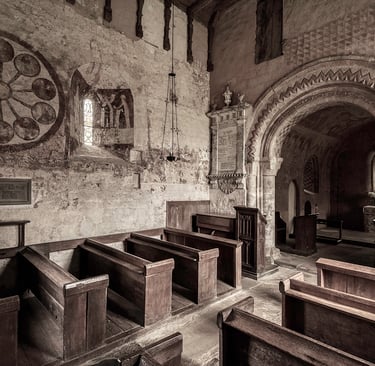
In the quiet expanse of the Gloucestershire countryside, St Mary’s Church in Kempley stands as a hidden spiritual gem, a sanctuary where centuries of sacred devotion appear almost tangible. Built around 1130 by the influential de Lacy family, this ancient Norman church exudes an unexpected sense of calm and wonder. The very air around the church seems to shimmer with the devotion of generations past and the whispered prayers of countless pilgrims. In this tranquil solitude, far removed from the clamor of modern life, one is drawn into a sacred encounter that nurtures both faith and spirit.
The exterior of St Mary’s Church is modest—a simple rubble masonry structure, gracefully weathered by the passage of time. Yet, a careful examination reveals a deep history etched into every stone. Constructed during the Norman period, its design reflects the austere but enduring devotion of an era when every building was intended as a testament to the Almighty’s grace. As visitors follow the well-worn path to the entrance, they cannot help but imagine the countless souls who have passed through these doors, each leaving traces of prayers and hopes behind.
Within the church, a profound silence welcomes those who enter. The humble nave, with its low, sturdy ceiling and unadorned lines, directs the eye towards a chancel that unexpectedly bursts forth with vibrant medieval wall paintings. These Romanesque frescoes, dating from the early 12th century and enhanced over later periods, rank among the most complete sets in northern Europe. Their biblical scenes, depicting the cycle of life and even visions of the Apocalypse, seem to shimmer with a divine light, suggesting a dialogue between the sacred art of old and the modern quest for spiritual meaning.
The artistry within these walls is nothing short of miraculous. Many visitors linger before a striking image of Christ in Majesty—a portrayal which, despite the relentless march of time, continues to radiate an awe-inspiring presence. Each brushstroke appears to convey both vulnerability and triumph, capturing transcendent beauty that stirs deep emotion. It is not uncommon for one to feel, for a moment, that the ancient voices of the master painters are echoing through the centuries, chanting in a language of hope and faith. The careful restoration and conservation efforts over the years have preserved this message, affirming that the act of creation itself is a form of communion with God.
Beyond the internal marvels of St Mary’s Church, nature embraces the sanctuary, enhancing its spiritual resonance. Stepping outside, visitors are greeted by a picturesque panorama of gently undulating hills, ancient oaks, and meandering brooks that seem to sing hymns of creation. The isolation of the church, set amid such enchanting surroundings, intensifies its sense of sacredness. Here, the natural world and the man-made sanctuary merge in a quiet symphony of life and renewal. The horizon appears to lie where heaven and earth meet, and in such moments, a profound gratitude arises for the enduring splendour of the Creator’s handiwork.
The journey to this remote sanctuary is, in every sense, a pilgrimage. Those who venture along the winding, almost forgotten path find that history itself seems to have chosen this route for seekers of spiritual renewal. With each step along the route, thoughts turn inward, and the gentle solitude of the countryside invites sincere prayer. Near the ancient walls of the church, reflections arise on its transformation across the centuries. Originally a shrine welcoming pilgrims even before the upheavals of the Reformation, St Mary’s Church has long stood as a beacon of hope and resilience—its stone walls silently testifying to the evolution of worship, from the illuminated pages of medieval frescoes to the heartfelt prayers of modern devotees.
During moments of quiet meditation inside the church, many experience a deep, personal connection with God—one that transcends time and circumstance. When one kneels upon the modest stone floor, it seems that the prayerful voices of the past mingle with those of the present, as if the very walls whisper assurances of divine love and protection. This intimate communion, fostered by the isolation of the church and the pristine beauty surrounding it, transforms it into a sanctuary not only for the soul but also for a restless heart in search of solace. It becomes clear that quiet prayer can form a powerful bridge between the frailty of human nature and the endless mercy of God.
The history of St Mary’s Church itself is layered and rich, much like the delicate paint upon its walls. Originally established by the de Lacy family, who were patrons of both art and faith, the church is believed to have replaced an earlier Saxon place of worship. Over the centuries, its interior has been transformed—and at times even concealed—especially during the turbulent eras of iconoclasm and religious reform. The precious frescoes, once hidden beneath layers of whitewash, were rediscovered in the late nineteenth century. This act of resurrection was a profound moment—a rediscovery of beauty and faith that echoed the rebirth of spiritual insight in every pilgrim who visited. Each delicate remnant of ancient artistry thus invites modern seekers into an ongoing dialogue between past and present.
As one absorbs the full impact of this hallowed history, subtle details come to light. The ancient timber roof, recognised as one of the oldest surviving in England, lends an almost tangible sense of wonder to the space. Its time-worn beams, smoothened over generations of prayer, serve as a gentle reminder that once ignited, true faith endures the test of time. Chequerboard patterns around the chancel windows, modest stone carvings, and even the faint aroma of centuries past coalesce into an experience that enriches both mind and spirit, inviting every visitor into a private communion with history and the divine.
For those in search of an escape from the frenetic pace of everyday life—a chance to rediscover the sacred in the midst of natural splendour—St Mary’s Church in Kempley offers a transformative journey. Visitors depart with hearts that feel fuller and spirits that have been reawakened by the unmistakable presence of God. There is an ineffable potency in standing in a place where the physical world, steeped in natural beauty, appears to converse with the divine. The church’s seclusion in such a picturesque setting creates an ambience for prayer that remains profoundly undisturbed, where every sound and every shadow holds the potential to become a silent sermon reflecting the enduring power of faith.
In reflection, such pilgrimages are not mere excursions into the annals of history; they are sacred acts of renewal. Each ancient stone and every faded brushstroke testifies to humanity’s timeless quest for divine connection. Within the stillness of that holy place, one finds not only solace but the inspiration to live a life enriched with gratitude and deeper faith. Every recollection of the journey serves as a gentle reminder that the presence of God is not confined solely to grand cathedrals or bustling congregations but is equally revealed in quiet, humble edifices that stand proudly amidst nature’s majesty.
As the day draws to a close and those who have visited retrace their steps out of the churchyard, a final pause for prayer often occurs—a prayer of thanks for the profound invitation to experience such beauty and tranquillity. It becomes evident that the journey to St Mary’s Church is as much an inward pilgrimage as it is a physical one. Amid the interplay of ancient art, whispered history, and the unyielding calm of the English countryside, the divine is encountered in a manner that transcends words. It is a moving reminder that sometimes, away from the clamour of daily routines, one is granted a brief glimpse of a realm where past and present harmonise, drawing one ever closer to a deeper understanding of God’s eternal grace.
Thus, the story of St Mary’s Church in Kempley unfolds as a timeless pilgrimage—a sanctuary where history breathes, nature sings, and prayer transforms into a living conversation with the divine. It stands as a solemn invitation for future wayfarers to embark on their own journey to this serene haven, to experience the quiet majesty of its ancient walls, and to discover, within its mindful silence, that spark capable of igniting a deeper, more heartfelt connection with God.
A Pilgrimage of the Soul: A Journey to St Mary’s Church, Kempley
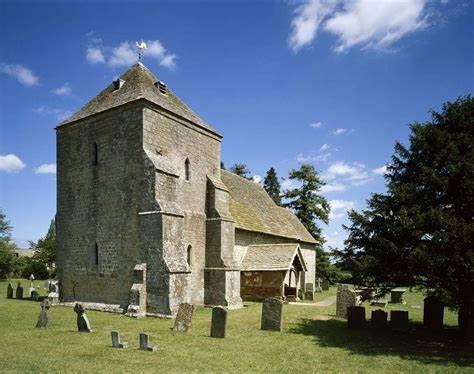

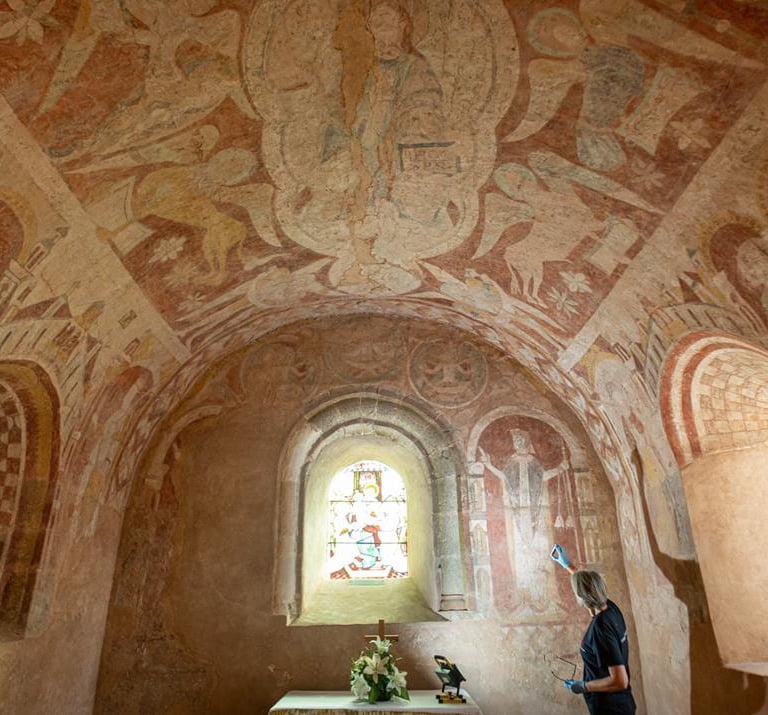


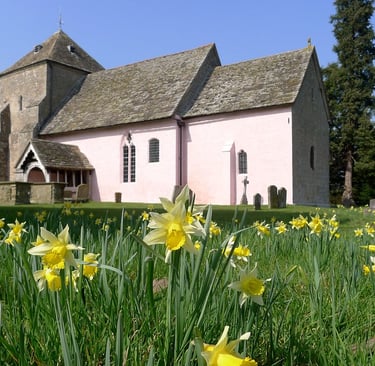

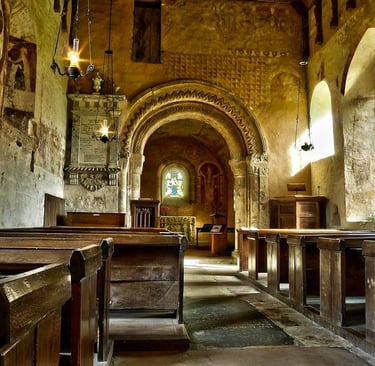
Ancient Apostolic Catholic Church
Embracing faith, inclusion, and compassionate service together.
ST THOMAS AQUINAS SEMINARY
© 2025. All rights reserved
QUICK LINKS
